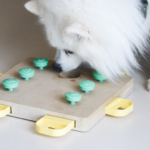Introduction
Teaching your dog tricks and signals goes beyond just entertaining party guests. It’s a way to strengthen the bond between you and your furry friend while also enhancing their mental stimulation and communication skills. In this guide, we’ll explore practical tips and strategies for teaching your dog a variety of tricks and signals that will not only impress but also foster a deeper connection between you and your canine companion.
Understanding the Importance of Communication
Communication is key in any relationship, and when it comes to our furry companions, understanding their unique language is essential for fostering a strong bond. Dogs primarily rely on body language and vocalizations to convey their thoughts, feelings, and needs. By deciphering these signals and incorporating tricks and signals into their training, we can bridge the gap between human and canine communication styles, leading to a deeper connection and mutual understanding.
Body language plays a significant role in a dog’s communication repertoire. Everything from the position of their ears and tail to the stance of their body can convey important messages. For example, a wagging tail typically indicates happiness or excitement, while a lowered head and flattened ears may signal fear or submission. By observing and interpreting these cues, pet owners can better understand their dog’s emotional state and respond accordingly.
In addition to body language, vocalizations such as barks, whines, and growls also play a crucial role in canine communication. Each vocalization carries its own meaning, whether it’s a playful bark during playtime or a low growl signaling discomfort or aggression. By paying attention to the tone, pitch, and frequency of their dog’s vocalizations, owners can gain insight into their pet’s thoughts and feelings.
Learning tricks and signals can further enhance communication between humans and dogs. Teaching your dog to respond to commands like sit, stay, and come not only promotes obedience but also provides a structured means of communication. These basic commands serve as building blocks for more advanced tricks and signals, allowing dogs to express themselves in a variety of situations.
Getting Started with Basic Commands
Getting started with basic commands is the foundation for effective communication between you and your furry friend. Foundational commands such as sit, stay, and come are essential building blocks that set the stage for more advanced tricks and signals. These commands not only establish a framework for obedience but also provide a means for clear and consistent communication with your dog.
The “sit” command is often one of the first commands taught to dogs and serves as a fundamental skill in their training repertoire. To teach your dog to sit, start by holding a treat close to their nose and then slowly lift it up and back over their head. As their head follows the treat, their bottom will naturally lower to the ground. Once they are in the sitting position, praise them and give them the treat.
“Stay” is another crucial command that helps your dog learn self-control and restraint. Begin by asking your dog to sit, then hold your hand out with your palm facing them and say “stay” in a firm but gentle voice. Start with short durations and gradually increase the time as your dog becomes more comfortable with the command. Remember to reward them for staying in place, even if it’s just for a few seconds at first.
The “come” command is vital for calling your dog to you, especially in potentially dangerous situations. Start by using a leash in a safe, enclosed area and gently tug on the leash while saying “come” in an upbeat tone. When your dog comes to you, reward them with praise and treats. Gradually increase the distance between you and your dog as they become more reliable with the command.
Building on Success with Positive Reinforcement
Building on success with positive reinforcement is a cornerstone of effective dog training. Positive reinforcement techniques, such as treats and praise, play a crucial role in motivating and rewarding your dog during training sessions. By utilizing these methods, you can encourage desired behaviors and strengthen the bond between you and your furry companion.
Positive reinforcement works by associating desired behaviors with pleasurable consequences, making it more likely that the behavior will be repeated in the future. When your dog performs a command correctly or exhibits a desired behavior, immediately reward them with a treat, verbal praise, or physical affection. This positive feedback helps reinforce the behavior and encourages your dog to continue performing it.
One of the key benefits of positive reinforcement is that it creates a positive learning experience for your dog. Rather than focusing on punishment or correction for mistakes, positive reinforcement emphasizes the positive aspects of training and encourages your dog to actively participate and engage in the learning process.
When using treats as a form of positive reinforcement, it’s essential to choose high-value rewards that your dog finds particularly enticing. This could be pieces of their favorite treats or special toys that they enjoy playing with. By using rewards that your dog values, you can effectively capture their attention and motivate them to work towards earning the reward.
In addition to treats, verbal praise and affection are also powerful forms of positive reinforcement. Using a cheerful and enthusiastic tone of voice when praising your dog can help convey your excitement and reinforce their good behavior. Physical affection, such as petting or gentle scratches, can also serve as a meaningful reward and strengthen the bond between you and your dog.
Teaching Advanced Tricks and Signals
Once your dog has mastered basic commands, you can embark on the exciting journey of teaching them advanced tricks and signals. These advanced behaviors not only showcase your dog’s intelligence and agility but also strengthen the bond between you and your furry friend. Here’s how you can teach your dog some impressive tricks and signals:
- Shaking Hands: To teach your dog to shake hands, start by commanding them to sit. Hold a treat in your closed fist and present it to your dog, allowing them to sniff and paw at it. As they paw at your hand, say the command “shake” and reward them with the treat. Repeat this process until your dog consistently raises their paw in response to the command.
- Rolling Over: Teaching your dog to roll over requires patience and repetition. Begin by commanding your dog to lie down on their side. Hold a treat close to their nose and slowly move it in a circular motion towards their shoulder, encouraging them to roll onto their back. As they roll over, say the command “roll over” and reward them with the treat. Gradually fade out the hand motion and rely solely on the verbal command.
- Playing Dead: Playing dead is a fun and impressive trick that requires your dog to lie on their side with their legs extended. Start by commanding your dog to lie down. Hold a treat in front of their nose and slowly move it towards the ground, guiding them into a lying position on their side. As they lie down, say the command “play dead” and reward them with the treat. With practice, your dog will learn to hold the position for longer durations.
- Adding Hand Signals: Alongside verbal commands, you can introduce hand signals to cue your dog’s behavior. For example, you can use a flat hand held up to signal “stop” or a pointed finger to indicate “come.” Pairing hand signals with verbal commands can enhance your dog’s understanding and responsiveness.
- Speak/Bark on Command: Teaching your dog to speak or bark on command can be a fun and useful trick. Start by encouraging your dog to bark naturally by using a trigger such as a doorbell ring or knocking on a surface. As soon as they bark, say the command “speak” or “bark” and reward them with a treat. Repeat this process until they start associating the command with the action. Gradually, introduce the command without the trigger, and reward them when they bark on cue.
- Spin/Twirl: Teaching your dog to spin or twirl is a delightful trick that showcases their agility and coordination. Begin by commanding your dog to stand facing you. Hold a treat in your hand and lure them in a circular motion by moving the treat around their nose. As they follow the treat with their nose and start turning in a circle, say the command “spin” or “twirl” and reward them with the treat. Practice this motion in both directions until your dog can perform a full spin on command.
Troubleshooting Challenges
Training your dog to perform tricks and respond to commands can be a rewarding experience, but it’s not without its challenges. As you embark on this journey with your furry friend, it’s essential to be prepared for common obstacles that may arise along the way. Here are some troubleshooting tips to help you overcome training challenges:
- Distractions: Dogs are naturally curious creatures, and they can easily become distracted by their surroundings during training sessions. To address this challenge, start training in a quiet and familiar environment free from distractions. Gradually introduce distractions one at a time, such as other pets or noises, and reinforce focus and obedience with treats and praise.
- Stubbornness: Some dogs may exhibit stubborn behavior during training, refusing to follow commands or perform tricks. In such cases, it’s crucial to remain patient and persistent. Break down the training process into smaller, more manageable steps, and reward any progress your dog makes, no matter how small. Consistency is key, so stick to your training routine and avoid giving in to your dog’s demands.
- Fear or Anxiety: Dogs that are fearful or anxious may struggle with training, as they may associate certain commands or actions with negative experiences. If your dog displays signs of fear or anxiety during training, such as trembling or avoidance behaviors, take a step back and assess the situation. Create a safe and supportive training environment, and use gentle, positive reinforcement techniques to build your dog’s confidence gradually.
Conclusion
Incorporating tricks and signals into your dog’s training regimen is not only a fun and rewarding activity but also a valuable way to strengthen your bond and improve communication with your canine companion. By following the tips and techniques outlined in this article, you can set your dog up for success and enjoy the many benefits of a well-trained and communicative pet.







